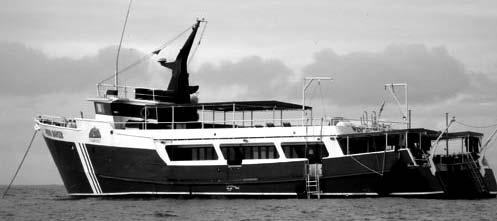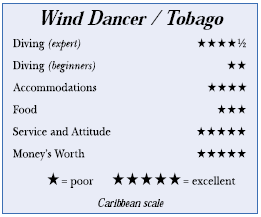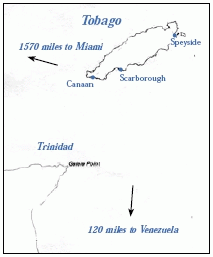Wind Dancer, TobagoContents of this Issue: Nekton Pilot Plays Reservation Roulette Computers That Properly Penalize Reverse Profiles When Divers Get Benched: Part III Divers, the Internet and the Industry: Part I Editorial Office: Ben Davison Publisher and Editor Undercurrent 3020 Bridgeway, Suite 102 Sausalito, CA 94965 the Caribbean's best advanced diving? from the May, 2006 issue of Undercurrent
Dear Reader: Drifting with the surge through coral-covered canyons, I passed nurse sharks snuggled into overhangs, seeking refuge from the current. Two squid pulsated frantically to get away. I glided over magnificent barrel, strawberry vase and tube sponges. Dozens of feeding tarpon circled a bait ball just below the surface of pounding waves. This was the “Alps,” indeed an exotic Tobago destination. Diving didn’t begin on a good note. Our first site was a disappointing basic checkout at 20 ft. in low visibility over a sandy bottom, so several novices could check their buoyancy. I entertained myself practicing deploying a mandatory Hughes-supplied reel tied to a safety sausage. However, the next swim was at the seldom-visited Diver’s Reef. Exposed to the tumultuous Atlantic, it was calm enough for us to take a two-knot current ride across a plateau at 70 feet. Several black tip sharks stayed their distance, but a hawksbill turtle hung with me briefly. A school of spadefish followed two king mackerels. Uniquely shaped sponges hid an oversized lobster. I considered it an advanced dive, a very good dive, and already the novices were loving the drift. The 81-degree water seemed warmer than the January air.
When I planned my trip, Hughes staffer Jeff recommended
that I
(and another
couple) arrive
in Trinidad a
day early to
avoid catching
the last
connecting
flight to
Tobago and
risk missing
the Wind Dancer’s departure. Made sense, especially
because late-arriving live-aboard guests
often cause those onboard to miss dives. Onboard the Wind Dancer, Captain Mike Kozlow told us that the weather forecast was for sun and calm seas. We’d head northeast toward Speyside for the good diving. On board since September, he’s a former eel fisherman and urchin diver who has worked on a Nekton. Like the Energizer Bunny, he continually puttered around the boat, helping divers. A fun, hospitable man. Guest services manager Lynne Marshall-Dunn, who had been a dive instructor in the Red Sea, Palau, and the Philippines, explained the Dancer’s safety features. Then, plans changed. Three Canadians and two Texans had been scheduled on the last flight to Tobago and, sure enough, they missed it, as did two suitcases and a dive bag (which didn’t show up for three days). So, we headed to Store Bay, near the airport, to wait for the morning and the tardy passengers. We couldn’t get into the water until they signed the obligatory liability forms, so we missed at least one dive before we rounded Pigeon Point and headed northeast into the Caribbean. Diving was from two custom-built 25-foot fiberglass Bimini-top tenders –- Trini and Bago –- with center console tank holders where our gear remained all week. They filled the 3000-psi tanks (usually to 2800 psi) with hoses stretched from the Dancer. I’d gear up on the 10-20 minute ride to dive sites. The strictly enforced 45-minute dive (plus safety stop) began with a back roll off the tender, then straight down, with no dawdling, which often meant I’d wait on the bottom for novice ear-clearing, eating up precious dive minutes. While the tenders allegedly rotate sites, I soon realized that the other boat headed to more advanced sites. When I asked to be moved to the other boat, Lynne “honeyed” me, saying, “you know, we try to keep friends together.” (Not such a good idea with some divers clearly advanced and some divers clearly novice.) The second day they moved me to the other boat, where I was happier just thinking I was visiting the more advanced sites, though the experience mix on both boats appeared equivalent. Northeast to Mt. Irvine Bay for critter diving. A shortnose batfish ate bristle worms in the sand. A colorful juvenile queen angel and juvenile spotted drums were skittish. Channel crabs and spiny lobster peered from crevices, while urchins and hermit crabs clung to the rocks. A sand tilefish darted into his hole. Afterwards, guides Roland “CNN” Williams, Leslie “Motley” James, and Tyson Kent, all locals, checked us in as we boarded on the lower dive deck, then handed us warm towels after a warm water rinse or a trip to the dive deck head. The three guys were excellent, skillful divemasters, and fun loving. After two days of great weather, rain came, dropping the visibility. To reach Sisters, a cluster of five rock pinnacles, it was a rough ride in choppy seas, well worth it for the divers on Trini –- not me –- who saw a dozen l0-foot hammerheads. A squall dumped buckets and the chop became three-foot swells. The weather didn’t discourage two mating green turtles, however, which only disengaged when the tender approached. Tyson then led us in the lee of Sisters number 2, where I saw several cherubfish before the current changed directions. And so did we. A downward surge took me on an exhilarating roller coaster ride. When I surfaced with the group, the water was thick with dome jellies. Boarding the tender was never easy in rough water. Most divers climbed aboard a sturdy ladder after removing their fins; a firm handhold timed with the rise and swinging of the tender is essential. One could doff gear in the water with one hand, holding onto the rope draped over the bow with the other, to avoid drifting away. It was impossible to swim against the surface current to reach the boat. Trinidad and its smaller sister Tobago are located at the turbulent convergence of the Atlantic and Caribbean, northeast of Venezuela. Strong and unpredictable currents, surge, and volatile ocean conditions make dive planning difficult, yet the briefings were usually on the mark, with the caveat about changing currents. While I don’t like being timed or herded, it’s the drill here and I appreciated guides who could read the currents and keep us out of washing machines. Visibility is unpredictable –- in January it ranged from 50-100 ft. It can change during a dive (in April and May, and to a lesser extent during the summer, it drops considerably). We had to stay close to see one another and surface together. The guide would either tether a float from a reel or inflate his safety sausage during our ascent to keep the driver informed. The Wind Dancer is one of the fleet’s older craft, having previously sailed the waters of Turks and Caicos Islands. Eight spacious lower deck cabins each have a queen bed with an upper bunk, side-by-side closets over drawers, a sink with vanity, and a bath and shower. The main deck master suite has a queen bed, larger bath, DVD player, and real windows. And then there is morning room service coffee or chocolate, thick terry robes, daily housekeeping and nightly turn down service with a chocolate on the pillow. The spacious salon has four tables with a full-size bar, an entertainment center, and a well-stocked library. The back corner has two pillowed leather couches across from the fully inventoried “boatique”. The sun deck is expansive with lounge chairs, a bar, and a barbecue that was fired up Thursday night. Cook Anton Gray boasted that we would have the best live-aboard food ever. Unfortunately, he hasn’t been on many other boats. The fare was good and plentiful, but, other than local specialties like the spinach-like calaloo, breadfruit in coconut milk, and fiery hot sauce, his meals were unexceptional. “The first drink is your last dive,” but there was seldom time to drink the complimentary hard liquor, Chilean wine and Carib beer until divers decided to skip night diving. And many did later in the week. Though night dives started an hour after dinner, around 8 p.m., one night the dive didn’t finish until 11:30 p.m., due to a broken running light on the tender. Full breakfasts were offered and lunch was an almost dinner-sized buffet featuring tacos, salads, vegetables, and homemade soup. A sweet roll, coffee cake or brownie was served late morning, afternoon snacks were such fare as fried calamari or stuffed jalapenos, heavy enough to spoil one’s appetite for dinner. Stewardess Anne Trinidad shared two years of boat seniority with CNN. She delivered room service, served dinner, and changed linens and towels on Tuesday. The lady can also “wine” or gyrate her hips while dancing to Calypso, which she did after much coaxing from the crew at our final party, a surf and turf dinner. The Wind Dancer typically circles Tobago, anchoring each day in sight of
rolling hills, palm-lined beaches, and lush tropical rain forests. Here are multiple dive sites –- some brain and plate corals were bleached –- and several landbased operators. Colorful houses perch on the verdant hillside. Cactus drapes over rocks below the lush rainforest. Long-tail white tropic birds flew high above. Local fishermen plied the water in blue-colored pirogues with bamboo outriggers, catching kingfish and lobster to sell to the Wind Dancer. Black Hole Jack was an underwater coral hillside of gorgonians, corky sea fingers, sea rods, swollen-knob candelabrum, and white eye sea spray. There were fields of magnificent yellow pencil coral, humongous brain coral, and sheet and scroll coral. Out of the blue, a school of spadefish greeted us. A black remora bugged the hell out of a queen angelfish. Lobster and king crab peeked out of holes, while a green turtle slept under a rock. A red sea horse clung to the base of a sea plume. Yes, another excellent dive. And then there is Coral Gardens, home of Tobago’s signature brain coral. At a depth of 55 feet, the massive specimen is 16 feet wide and 12 feet tall, and home to green, beige and blue lettuce sea slugs. At Bookends, named for twin pinnacles with a vertical cut separating them, a school of tarpon swam in surf crashing against the rocks. On the third dive that day I was enveloped by a school of blue tangs, had a close encounter with a nurse shark, and admired a large, ancient,coral-encrusted anchor. Several lined seahorses clung shyly to gorgonians. After that, a two-hour steam to Scarborough, the home port, an overnight, and an 8 a.m. enforced departure from the boat. Indeed, a good, fairly priced trip. I’ve been most everywhere in the Caribbean, and the Dancer took me to some of the most advanced and most interesting dives I’ve had. It’s off the beaten path and the two days of travel reduce the crowds. Those who come should be physically fit to handle the strong currents and surge. Safe, calm anchorages are few and far between. For those who don’t have a couple dozen dives under their belts and aren’t up to par for these waters, Belize would be a more suitable live-aboard destination. –G.S.
|

I want to get all the stories! Tell me how I can become an Undercurrent Online Member and get online access to all the articles of Undercurrent as well as thousands of first hand reports on dive operations world-wide
| Home | Online Members Area | My Account |
Login
|
Join
|
| Travel Index |
Dive Resort & Liveaboard Reviews
|
Featured Reports
|
Recent
Issues
|
Back Issues
|
|
Dive Gear
Index
|
Health/Safety Index
|
Environment & Misc.
Index
|
Seasonal Planner
|
Blogs
|
Free Articles
|
Book Picks
|
News
|
|
Special Offers
|
RSS
|
FAQ
|
About Us
|
Contact Us
|
Links
|
3020 Bridgeway, Ste 102, Sausalito, Ca 94965
All rights reserved.


 I
overnighted at the basic Pax Guest House,
with a great view of the mountains. The
next morning, I arrived in Tobago with four
hours to kill. My expected Hughes greeter
wasn’t there, so I lugged my baggage to the
tourist office and called him. According to
reports in the Chapbook, most Dancer clients
hang out at the Hilton before departure.
My reluctant driver wanted $10 to
take me there -– he didn’t work for Hughes
and was paid only to get me to the boat
from the airport, so I ended up poolside at
the airport Crown Point hotel.
I
overnighted at the basic Pax Guest House,
with a great view of the mountains. The
next morning, I arrived in Tobago with four
hours to kill. My expected Hughes greeter
wasn’t there, so I lugged my baggage to the
tourist office and called him. According to
reports in the Chapbook, most Dancer clients
hang out at the Hilton before departure.
My reluctant driver wanted $10 to
take me there -– he didn’t work for Hughes
and was paid only to get me to the boat
from the airport, so I ended up poolside at
the airport Crown Point hotel.  On the northern
part of the island, Cliff Hanger was a drift over a plateau covered with oddshaped
sponges. A 10-foot nurse shark was tucked
under a ridge, but I couldn’t stop for a better
look. A handheld GPS from the boat registered a
mere 1.3 knot current. And rain continued and the
boat rocked. Our plan to dive the Caribbean-side
St. Giles islands, allegedly the premier site of
the underwater London Bridge arch, were dropped.
Instead we motored through the turbulent Atlantic/
Caribbean convergence (about a half-hour ride) to
the calmer waters of Speyside harbor.
On the northern
part of the island, Cliff Hanger was a drift over a plateau covered with oddshaped
sponges. A 10-foot nurse shark was tucked
under a ridge, but I couldn’t stop for a better
look. A handheld GPS from the boat registered a
mere 1.3 knot current. And rain continued and the
boat rocked. Our plan to dive the Caribbean-side
St. Giles islands, allegedly the premier site of
the underwater London Bridge arch, were dropped.
Instead we motored through the turbulent Atlantic/
Caribbean convergence (about a half-hour ride) to
the calmer waters of Speyside harbor.  Divers Compass: American Airlines flies to Trinidad from Miami,
Continental from Houston and Newark . . . Tobago Express
(868.627.5160 or
Divers Compass: American Airlines flies to Trinidad from Miami,
Continental from Houston and Newark . . . Tobago Express
(868.627.5160 or 